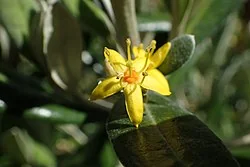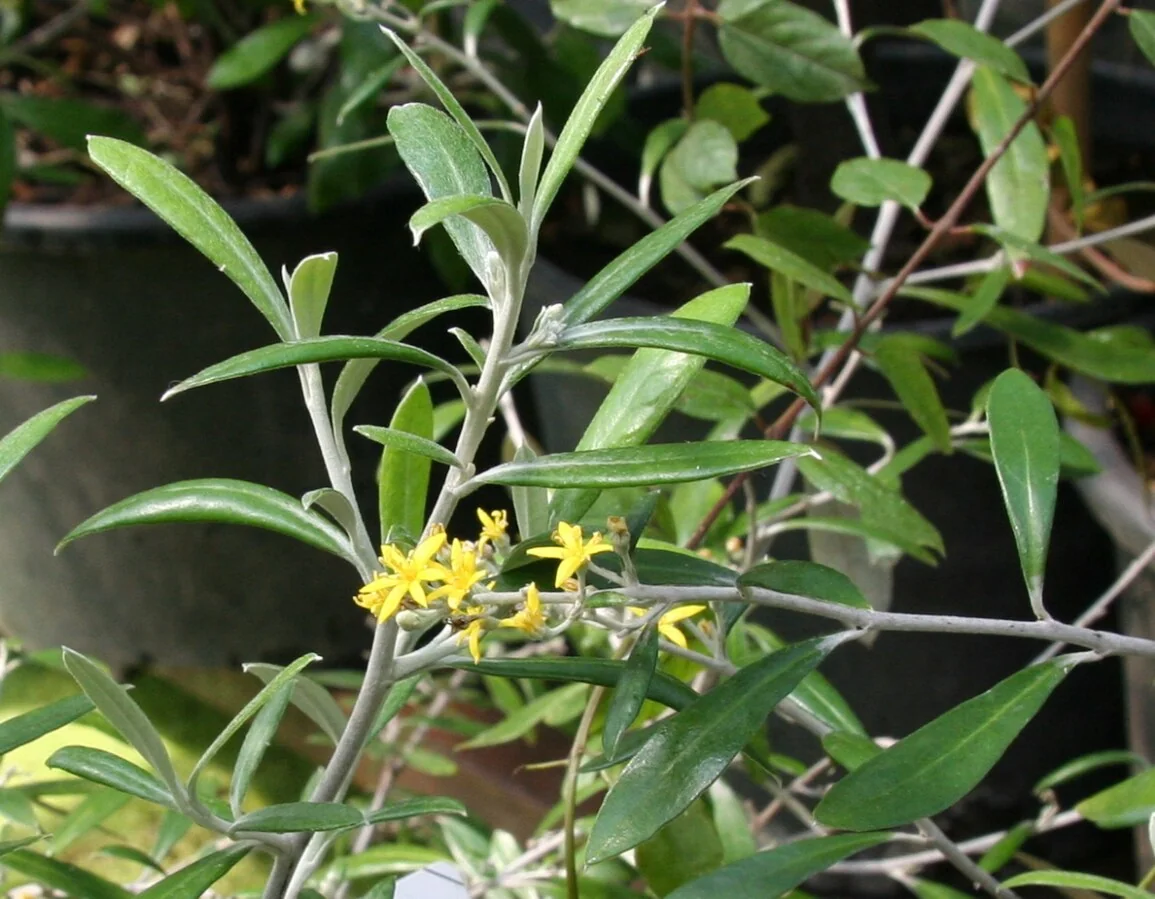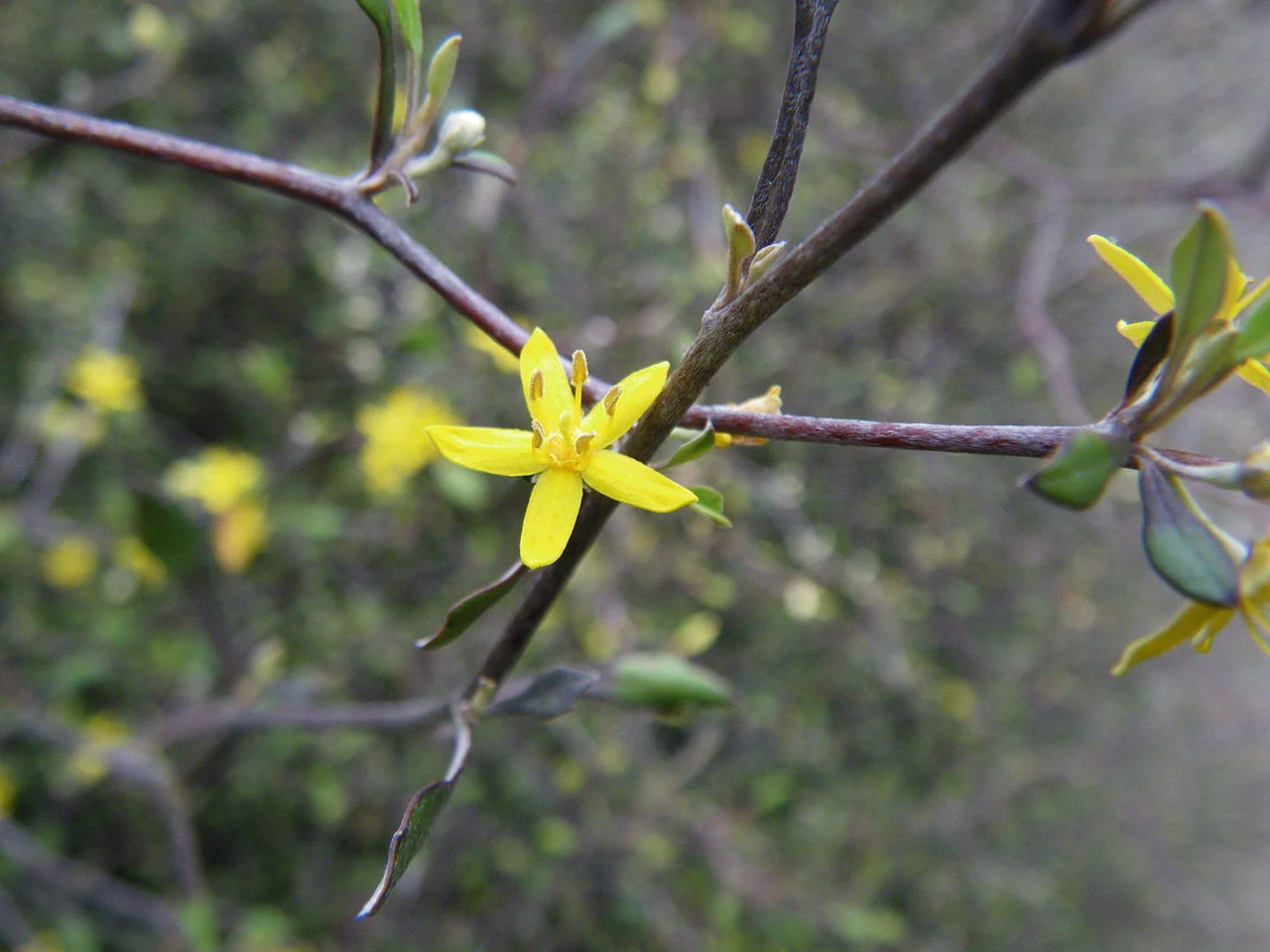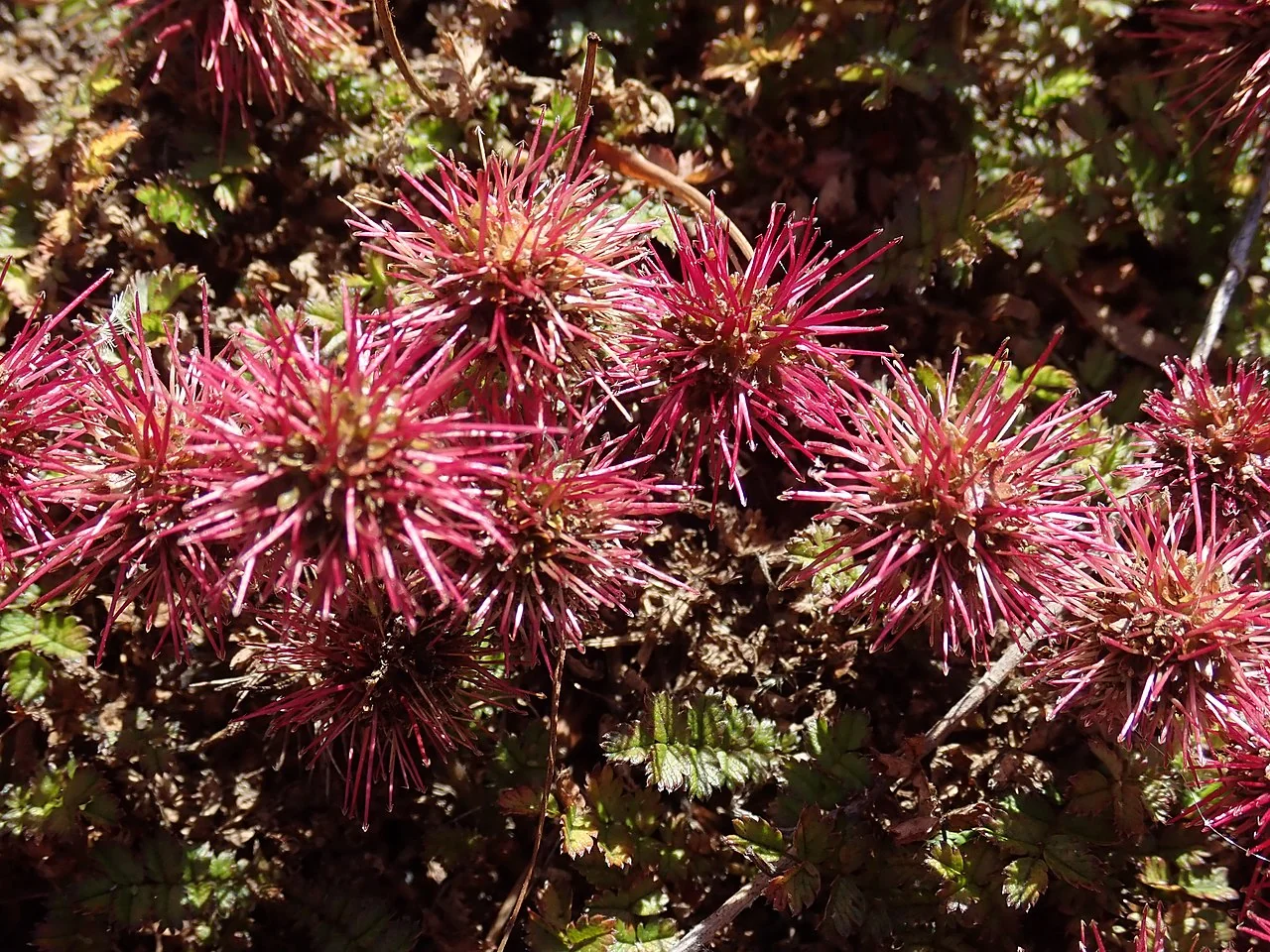
Chatham Islands Corokia
Corokia macrocarpa
Corokia macrocarpa , also known by its Māori names hokotaka and whakataka, is a distinctive evergreen shrub among New Zealand's native shrubs or small tree native and endemic to New Zealand's Chatham Islands. It can grow up to 8 meters tall and is characterized by its twisted, zigzagging branches and rough, charcoal-grey bark. Its leaves are typically grey-green or sage-green, somewhat leathery, and have a silvery or white, fuzzy underside. These alternate leaves are obovate-cuneate to broad-oblanceolate or elliptic-oblong, measuring 40-80 mm long by 15-35 mm wide. In spring and summer, Corokia macrocarpa produces masses of small, star-shaped yellow flowers with orange centers. These are followed by clusters of conspicuous, globose berries, 10-12 mm in size, which are typically yellow or orange, and occasionally dark orange-red. These fruits are attractive to native birds. This resilient plant is well-adapted to harsh coastal conditions, including strong winds, salt spray, and a range of soil types, from sandy to rocky or clay. It is drought-tolerant once established and can withstand temperatures from -20â to 35â.

Plant Description
Botanical Features
Corokia macrocarpa , also known as Chatham Islands Corokia, Hokotaka, or Whakataka, is a distinctive evergreen shrub or small tree native and endemic to New Zealand's Chatham Islands. It can grow up to 8 meters tall and is characterized by its twisted, zigzagging branches and rough, charcoal-grey bark. Its leaves are typically grey-green or sage-green, somewhat leathery, and have a silvery or white, fuzzy underside. These alternate leaves are obovate-cuneate to broad-oblanceolate or elliptic-oblong, measuring 40-80 mm long by 15-35 mm wide. In spring and summer, it produces masses of small, star-shaped yellow flowers with orange centers, followed by clusters of conspicuous, globose berries, 10-12 mm in size, which are typically yellow or orange, and occasionally dark orange-red. This resilient plant is well-adapted to harsh coastal conditions, including strong winds, salt spray, and a range of soil types, and is drought-tolerant and frost-hardy.
Quick Facts
| Scientific Name | Corokia Macrocarpa |
|---|---|
| Height | 2-4 m |
| Spread | 2-3 m |
| Water Needs | Low to moderate |
| Light | Full sun to part shade |
| Frost Tolerance | Moderate |
| Salt Tolerance | Excellent |
| Growth Rate | Slow to moderate |
| Lifespan | Long |
Climate Best Suited to
Chatham Island Akeake ( Corokia macrocarpa ) prefers mild, maritime climates with protection from extreme weather. It adapts well to typical New Zealand growing conditions with appropriate care and positioning.
Regional Suitability
| Whangārei | Ideal |
| Auckland | Ideal |
| Hamilton | Suitable |
| Rotorua | Suitable |
| Tauranga | Ideal |
| Gisborne | Ideal |
| New Plymouth | Ideal |
| Whanganui | Ideal |
| Palmerston North | Suitable |
| Napier | Ideal |
| Wellington | Ideal |
| Nelson | Ideal |
| Christchurch | Suitable |
| Dunedin | Suitable |
| Invercargill | Suitable |
| City | Climate Suitability |
|---|
Natural Habitat
The Chatham Islands Corokia ( Corokia macrocarpa ) is a remarkable shrub or small tree endemic to the remote Chatham Islands of New Zealand. This resilient species is widespread across the main islands of the Chatham archipelago, thriving in an impressive array of habitats from the coast to the highest elevations. It can be found growing on exposed sand dunes, coastal headlands, and rocky outcrops composed of basalt, schist, or limestone. It also colonizes the margins of lakes and can be a significant component of dense island forests. This adaptability highlights its exceptional tolerance to the harsh maritime conditions of the Chatham Islands, including strong winds, salt spray, and periods of drought. While it prefers dry, well-drained sites, its presence in diverse environments underscores its hardiness and its vital role in the unique ecosystems of these isolated islands.
Plant Conservation
The conservation status of Corokia macrocarpa is "At Risk - Naturally Uncommon" as of 2023. This classification includes the qualifiers IE (Island Endemic) and RR (Range Restricted). This status has been consistent in previous assessments, including those in 2012 and 2017.
Corokia macrocarpa is a species endemic to the Chatham Islands, New Zealand, where it is found on Chatham, South East, Pitt, and Mangere islands. It grows in a variety of habitats, from coastal areas to the highest points on the main islands, including sand dunes, coastal headlands, rock outcrops, lake margins, and dense forests.
Growing Requirements
Soil Requirements
Chatham Island Akeake ( Corokia macrocarpa ) performs best in well-draining soil that retains adequate moisture. Like most New Zealand natives, it prefers soils that don't become waterlogged but maintain consistent moisture levels. Good drainage is essential for healthy root development.
- Well-draining soil essential for healthy growth
- Prefers consistent moisture without waterlogging
- Adapts to various soil types with good drainage
- Benefits from organic matter incorporation
- Mulching helps retain moisture and suppress weeds
Light Requirements
Chatham Island Akeake ( Corokia macrocarpa ) performs well in full sun to partial shade conditions. Like many New Zealand natives, it adapts to various light conditions but typically shows best growth and form in positions that receive adequate sunlight throughout the day.
- Full sun to partial shade positions
- At least 4-6 hours of direct sunlight daily
- Tolerates light shade in warmer climates
- Morning sun particularly beneficial
Water Requirements
Chatham Island Akeake ( Corokia macrocarpa ) requires regular watering during establishment, typically for the first 1-2 years. Once established, it becomes more drought-tolerant but benefits from consistent moisture during dry periods. Avoid overwatering which can lead to root problems.
- Regular watering during establishment phase
- Moderate drought tolerance once established
- Consistent moisture during dry periods beneficial
- Avoid waterlogged conditions
- Mulching helps conserve soil moisture
Planting Guide
When to Plant
The ideal time for planting or transplanting Corokia macrocarpa is during the gentle warmth of late spring to early summer. This allows the roots to establish before hotter months and ensures optimal growth and resilience. It can also be planted in autumn.
Site Selection and Soil
- Sunlight: Thrives in full sun to partial shade, requiring at least 6 hours of sunlight daily for optimal growth.
- Exposure: Tolerant of coastal, windy, and exposed situations once established.
- Soil: Prefers well-drained soil and can adapt to a wide range of soil types, including sandy or rocky soils. For optimal growth, amend the soil with organic matter like compost to improve drainage and nutrient content. In heavier clay soils, consider planting on a raised mound and using gypsum clay breaker.
Planting Steps
- Dig a planting hole twice as wide and to the same depth as the root-ball.
- Gently tease the roots and cut away any circled or tangled roots before positioning the plant in the hole.
- Backfill with soil, gently firming it down.
- Form a raised, doughnut-shaped ring of soil around the outer edge of the plant's root zone to help retain water.
- Water thoroughly immediately after planting to settle the soil.
After Planting Care
Water regularly during the first 1-2 seasons, especially in dry climates, to help the roots establish. Once established, it is moderately drought-tolerant. Apply a balanced, slow-release fertilizer in early spring to encourage healthy growth.
Ecological Role
Environmental Benefits
Corokia macrocarpa , also known as hokataka or whakataka, plays a vital ecological role, particularly in the coastal ecosystems of its native Chatham Islands.
- Support for Wildlife: The plant produces small, star-shaped yellow flowers in spring to early summer that attract pollinators. These are followed by small, red to orange berries in autumn, which serve as a food source for local bird populations.
- Coastal Stabilization and Biodiversity: Corokia macrocarpa is well-adapted to harsh, windy, and salt-laden coastal conditions, thriving in environments with poor soils. Its drought and salt tolerance make it crucial for sustainable landscapes and windbreaks in these exposed sites. It grows in diverse habitats such as sand dunes, coastal headlands, rock outcrops, lake margins, and forest fringes, contributing to the overall biodiversity of these areas.
Uses and Significance
Garden Uses
- Excellent for native plant gardens and restoration
- Suitable for naturalistic landscape designs
- Low maintenance once established
- Contributes to local biodiversity
- Attractive to beneficial native wildlife
Cultural Significance
Traditional Uses and Values
While specific cultural uses for Corokia macrocarpa are not extensively detailed, the genus Corokia is native to New Zealand and the Māori word "Korokio" is associated with related species like Corokia cotoneaster. The plants in this genus are important for their ecological value, providing food and shelter for native birds and other wildlife. Their hardiness and unique sculptural form also make them a symbol of the resilience and distinctive character of New Zealand's native flora, particularly in challenging coastal environments.
Landscaping Uses
Garden Design Applications
Corokia macrocarpa is a versatile and resilient shrub highly valued for its diverse landscaping applications, particularly due to its hardiness, distinctive appearance, and tolerance to various environmental conditions.
- Hedging and Screening: It can be pruned to form dense, structured hedges, making it an excellent choice for creating privacy screens or defining garden boundaries.
- Coastal Gardens and Windbreaks: The plant exhibits strong tolerance to salt and wind, making it ideal for exposed coastal environments and effective as a windbreak.
- Native and Restoration Plantings: Originating from the Chatham Islands, Corokia macrocarpa contributes to coastal ecosystems and supports local bird and insect populations, fitting well into ecological restoration projects.
- Container and Patio Plantings: Its unique, architectural form makes it suitable for pots, adding a minimalist design element to patios, balconies, and small gardens.
- Feature or Specimen Shrub: With its sculptural shape, intricate wiry branches, and year-round textural interest, it serves as an eye-catching focal point in garden designs.
- Mixed Borders and Backdrops: It can be integrated into mixed plantings or used as a backdrop for smaller plants, providing contrasting colour and texture.
- Modern Landscapes: The plant's distinctive form and solid appearance complement contemporary architectural styles.
- Low-Maintenance Gardens: Once established, Corokia macrocarpa is drought-resilient and requires minimal care, making it suitable for low-maintenance garden designs.
Seasonal Care Calendar
Spring
Spring is an active growth period for Chatham Island Akeake ( Corokia macrocarpa ). New growth emerges and this is an ideal time for planting new specimens. Monitor soil moisture as temperatures warm and growth accelerates.
- Active growth period with new foliage development
- Ideal time for planting new specimens
- Monitor soil moisture as temperatures rise
- Apply organic mulch if needed
Summer
Summer is typically the main growing season for Chatham Island Akeake ( Corokia macrocarpa ). Ensure adequate watering during hot, dry periods, especially for young plants. Established plants show good heat tolerance with appropriate care.
- Peak growing season with active development
- Monitor watering needs during hot weather
- Young plants need consistent moisture
- Established plants show good heat tolerance
Autumn
During autumn, Chatham Island Akeake ( Corokia macrocarpa ) begins to slow its growth as temperatures cool. This is another good time for planting as conditions become more favorable. Reduce watering frequency but maintain soil moisture.
- Growth slows as temperatures moderate
- Good time for planting new specimens
- Reduce watering frequency gradually
- Maintain soil moisture without overwatering
Winter
Winter is typically a dormant period for Chatham Island Akeake ( Corokia macrocarpa ), with minimal growth activity. Reduce watering but ensure plants don't completely dry out. Most New Zealand natives are cold-hardy and require minimal winter protection.
- Dormant period with minimal growth activity
- Reduce watering but avoid complete drying
- Generally cold-hardy in most New Zealand climates
- Minimal winter protection required
When to Prune and How Much
Chatham Island Akeake ( Corokia macrocarpa ) generally requires minimal pruning to maintain its natural form and health. Most maintenance involves removing dead or damaged growth and light shaping if needed.
- Remove dead, damaged, or diseased growth as needed
- Light pruning to maintain shape if desired
- Prune after flowering if applicable
- Avoid heavy pruning which can stress the plant
- Use clean, sharp tools to prevent disease
- Most natives maintain good form without regular pruning
Always use clean, sharp tools when pruning to minimize disease risk. Native plants typically maintain their natural form well and often require less intervention than exotic species.
How to Grow Chatham Islands Corokia
From Fresh Orange Drupes
Fresh orange drupe propagation represents the most natural and essential method for growing Large-leaved Milk Tree, taking advantage of this rare Chatham Islands endemic species' specialized fruit production and natural dispersal strategy that has enabled it to persist across diverse island habitats from coastal sand dunes to forest margins throughout the challenging oceanic environment of the Chatham archipelago. This exceptionally hardy island endemic produces distinctive orange drupes following the spectacular display of bright yellow star-shaped flowers with orange centers that provide critical opportunities for conservation propagation while supporting the species' natural frugivory dispersal cycles essential for island ecosystem function and genetic diversity preservation. The species' remarkable adaptation to harsh island conditions including extreme wind exposure, salt spray, and variable soils from basalt to limestone makes it particularly valuable for challenging coastal garden situations and specialized restoration projects requiring plants capable of handling severe oceanic weather while providing unique island botanical heritage in mainland cultivation. Fresh drupe propagation allows cultivation of genetic diversity essential for ex-situ conservation while providing opportunities for gardeners to contribute to preservation of this threatened island endemic through careful cultivation and potential future reintroduction programs. Collect ripe orange drupes during autumn when fruits have achieved their characteristic bright orange coloration and can be easily removed from the silvery-leaved branches, timing collection to coincide with peak seed maturity for optimal viability and conservation success. Choose drupes that are fully developed, firm, and show the distinctive orange coloration typical of mature fruit, avoiding any that appear damaged, diseased, or prematurely dropped which might indicate compromised seed quality or reduced conservation value. Process drupes immediately after collection by macerating in water and thoroughly cleaning seeds, using gentle rubbing under running water to separate seeds from fruit pulp that could inhibit germination or promote fungal growth during the critical establishment period essential for rare species conservation. Clean seeds by repeated washing until all fruit debris is removed, as any remaining pulp can significantly interfere with germination success in endemic species that may have specialized germination requirements, retaining the viable seeds that settle to the bottom. Prepare optimal germination medium using free-draining seed-raising mix with excellent aeration properties and neutral pH levels that support healthy development for this specialized island species adapted to diverse Chatham Islands substrates. Sow fresh seeds immediately after processing, covering lightly with 2-3mm of fine sand to provide optimal conditions for emergence while maintaining protection from drying out that can quickly kill developing embryos of rare endemic species. Provide optimal environmental conditions including consistent temperatures between 15-20°C and bright light that supports germination while maintaining steady moisture without waterlogging throughout the potentially extended germination period characteristic of island endemics. Maintain careful moisture management throughout the 4-12 week germination period, as emergence can be slow and irregular in rare species, requiring patience and consistent environmental conditions while monitoring for precious emergence signs. Keep propagation trays for extended periods to accommodate the variable germination timing characteristic of island endemic species, ensuring optimal conditions are maintained throughout the potentially lengthy emergence window critical for conservation success. Young seedlings develop slowly while establishing the robust root systems necessary for adaptation to challenging island growing conditions, requiring protection from environmental stress and careful nurturing during vulnerable early establishment phases. Transplant successful seedlings when they reach 5-8cm height and have developed sufficient root systems to handle the transition to specialized growing conditions that support long-term cultivation of this rare island endemic. This method requires dedication and specialized care but provides irreplaceable opportunities for conservation propagation of genetic material from one of New Zealand's most distinctive island endemic shrubs, contributing to preservation efforts for Chatham Islands biodiversity.
From Specialized Island Cuttings
Specialized island cutting propagation offers a critical vegetative method for growing Large-leaved Milk Tree that preserves the exact genetic characteristics of precious parent material while providing essential backup propagation for this rare Chatham Islands endemic through techniques specifically adapted to challenging island species conservation requirements. This approach is particularly valuable for maintaining exceptional specimens that represent important genetic lineages from specific Chatham Islands populations, preserving adaptation traits that can be maintained through careful vegetative propagation techniques suited to this unique oceanic island specialist. The method requires specialized expertise due to this species' adaptation to extreme island conditions and potentially challenging rooting characteristics typical of endemic island flora that have evolved under isolated oceanic conditions. Take 8-12cm semi-hardwood cuttings from healthy, vigorous shoots during late summer to early autumn when growth has achieved optimal maturity for rooting while retaining sufficient vigor for successful establishment under carefully controlled conservation propagation environments. Select healthy, vigorous shoots from middle portions of branches that display the characteristic large grey-green leaves with distinctive white undersides and robust growth typical of healthy Large-leaved Milk Tree development, ensuring cutting material represents the best genetic characteristics available. Cut sections with clean, sterilized secateurs to prevent disease transmission, ensuring each cutting includes appropriate nodal development while selecting material that represents superior adaptation traits including wind tolerance and the distinctive silvery foliage that characterizes this remarkable island endemic. Remove lower leaves carefully to reduce transpiration stress while retaining sufficient photosynthetic capacity in upper leaves, taking special care not to damage the distinctive large leaves with white undersides that provide energy for root development during the critical establishment period. Wound cutting bases lightly to expose cambium tissue where new roots will develop, using specialized techniques that enhance root initiation in challenging island endemic species without causing excessive damage to precious cutting material. Apply rooting hormone formulations specifically appropriate for difficult endemic species, using specialized concentrations that enhance root initiation while ensuring even coverage of cut surfaces where new root systems must develop under challenging conditions. Insert prepared cuttings into carefully prepared cutting mix composed of premium propagation medium with excellent drainage characteristics, ensuring optimal growing conditions that support successful root development in this specialized island species without creating conditions that could damage rare genetic material. Maintain optimal environmental conditions including precisely controlled humidity (80-90%) and consistent temperatures around 18-20°C using specialized propagation facilities that provide the stable conditions essential for successful rooting of challenging island endemic species. Provide carefully filtered light that supports photosynthesis without causing stress to cutting material from this island species adapted to specific oceanic light conditions and salt-laden atmospheric conditions. Monitor cutting development throughout the extended 8-16 week rooting period required for island endemic species, maintaining consistent specialized environmental conditions while watching for signs of successful root development that indicate conservation propagation success. Root development occurs slowly as cuttings establish the specialized root systems characteristic of mature Large-leaved Milk Tree adapted to challenging island soils and extreme oceanic conditions that require careful long-term cultivation management. Pot successful cuttings into specialized growing mix and provide extended hardening off periods before transitioning to permanent cultivation conditions, ensuring successful establishment of this precious conservation material for long-term ex-situ preservation efforts.
From Conservation Habitat Establishment
Conservation habitat establishment provides the most comprehensive approach to growing Large-leaved Milk Tree that focuses on creating authentic island ecosystem conditions while contributing to long-term species preservation and potential future reintroduction programs for this critically important Chatham Islands endemic. This method requires extensive expertise and long-term commitment but offers the greatest potential for meaningful conservation contribution through establishing viable populations that can support ongoing research, genetic preservation, and potential restoration activities essential for island biodiversity conservation. Understanding this approach provides insights into complex island ecology while offering opportunities for advanced practitioners to contribute to meaningful conservation efforts for one of New Zealand's most distinctive endemic island species. Begin by developing comprehensive understanding of Chatham Islands ecology including substrate types, climatic conditions, plant associations, and ecological processes that support Large-leaved Milk Tree populations in their natural island environment. Design conservation plantings that incorporate authentic island habitat conditions including appropriate drainage characteristics, wind exposure levels, and companion species associations that reflect natural Chatham Islands plant communities where this species naturally occurs. Source plant material through combination of seed-grown specimens, cutting‑propagated plants, and collaboration with botanical institutions to ensure genetic diversity and authentic representation of Chatham Islands populations while maintaining proper documentation for conservation purposes. Prepare conservation sites by creating specialized growing conditions that replicate Chatham Islands substrates including well-drained soils with appropriate mineral content and pH levels that support authentic island plant community development. Establish specialized microclimate conditions that provide appropriate wind exposure, humidity levels, and temperature regimes that support successful adaptation to mainland conditions while maintaining the environmental challenges that maintain species vigor. Create authentic island plant community associations by integrating with other Chatham Islands endemic species where possible, developing diverse habitat structure that supports ecological relationships essential for long-term species persistence in cultivation. Implement specialized maintenance protocols including appropriate irrigation regimes, protection from inappropriate environmental conditions, and monitoring systems that support long-term conservation success while documenting growth and adaptation responses. Monitor establishment success through detailed record-keeping systems that document growth rates, flowering and fruiting success, adaptation responses, and any challenges encountered during establishment phases essential for conservation program development. Collaborate with botanical institutions, conservation organizations, and research programs to ensure conservation habitat establishment contributes to broader species preservation efforts while maintaining appropriate documentation and genetic tracking systems. Allow natural ecological processes including pollination opportunities and potential natural reproduction to enhance conservation value, creating dynamic conservation sites that support ongoing species research and potential future conservation applications. This approach requires expert-level knowledge and sustained long-term commitment but provides irreplaceable opportunities for meaningful conservation contribution to preservation of Chatham Islands biodiversity through practical habitat conservation and species preservation activities that support broader conservation goals for unique island ecosystems.
Pests and Diseases
Corokia macrocarpa is generally considered pest- and disease-resistant. However, there are a few issues to monitor:
Pests:
- Scale and aphids may affect stressed plants.
Diseases:
- Root rot: Is the most common disease, caused by overwatering or prolonged wetness. Symptoms include yellowing leaves, leaf drop, and darkening stems. Good drainage is essential to prevent this.
- Honey fungus: May affect Corokia macrocarpa in gardens where it is present, though data on its susceptibility is limited.
- Leaf yellowing: Can also indicate poor drainage, excessive shade, or nutritional deficiencies if the plant has not been fertilized for several years.
Bonus Tip
Expert Growing Advice
Corokia macrocarpa is endemic to the remote Chatham Islands, making it a unique and special addition to any garden. Its distinctive twisted, zigzagging branches and silvery-grey, leathery leaves give it a sculptural quality, providing year-round architectural interest. This hardy shrub is incredibly resilient, tolerating harsh coastal conditions, strong winds, and salt spray, making it an excellent choice for challenging environments where other plants might struggle.







